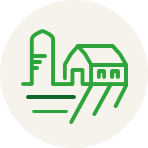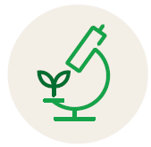
Lantmännen is an agricultural cooperative and Northern Europe’s leader in agriculture, machinery, bioenergy and food products.
Call text – Agriculture and machinery 2023
An important objective of the Lantmännen Research Foundation is to support the development of profitable and sustainable crop cultivation and animal production. Ongoing climate changes and a turbulent world situation emphasise the need for a well‐functioning food production sector from field to fork. It also includes issues such as energy supply, digital infrastructure, climate adaptation as well as effective consulting services and other systems to transfer knowledge from research to practice. The Foundation’s specific priorities are described below.
We see favourable that applicants contact us to discuss possibilities to use Lantmännen’s feeds, seeds, experimental facilities and other resources in projects being planned. For example, Lantmännen has extensive research activities in feed and plant breeding where various ideas can be studied cost efficiently with excellent data quality.
Read more about how we can cooperate to promote sustainable agriculture through research, innovation and practical on‐farm measures:
https://www.lantmannen.com/farming‐of‐the‐future/farming‐of‐the‐future‐the‐report
 Agriculture needs robust cultivation systems with high productivity under changing weather and climate conditions. Different cultivation measures need to be assessed with regards to climate impact and other aspects of sustainability. Certain measures can drastically increase yields but also result in new problems. For example, cropping systems dominated by winter crops gives high productivity but also new weed and pesticide problems which we must learn to manage.
Agriculture needs robust cultivation systems with high productivity under changing weather and climate conditions. Different cultivation measures need to be assessed with regards to climate impact and other aspects of sustainability. Certain measures can drastically increase yields but also result in new problems. For example, cropping systems dominated by winter crops gives high productivity but also new weed and pesticide problems which we must learn to manage.
Current research areas:
 A prerequisite for profitable production and processing of grains and other plant‐based commodities is that the quality specifications demanded are met. Different customers and different application areas impose different quality standards on these commodities. Sustainable grain management means ensuring the grain’s quality without drying, cooling and cleaning more than is necessary. All unnecessary measures hit the grain grower’s finances hard. Climate change with warmer autumns enables less need for grain drying but this in turn can increase the risk of attack by various storage pests and other problems.
A prerequisite for profitable production and processing of grains and other plant‐based commodities is that the quality specifications demanded are met. Different customers and different application areas impose different quality standards on these commodities. Sustainable grain management means ensuring the grain’s quality without drying, cooling and cleaning more than is necessary. All unnecessary measures hit the grain grower’s finances hard. Climate change with warmer autumns enables less need for grain drying but this in turn can increase the risk of attack by various storage pests and other problems.
Current research areas:
 An expansive livestock production is important for a sustainable food supply. Detailed information on the animal's nutritional needs and on physiological processes in the body must go hand in hand with the genetic progress for production potential that occurs continuously. Digital, technical and biotechnological development is also needed to find new solutions and approaches for a sustainable and circular livestock production.
An expansive livestock production is important for a sustainable food supply. Detailed information on the animal's nutritional needs and on physiological processes in the body must go hand in hand with the genetic progress for production potential that occurs continuously. Digital, technical and biotechnological development is also needed to find new solutions and approaches for a sustainable and circular livestock production.
Current research areas:
PDF (161 Kb)
We see favorably that applicants contact us to discuss possibilities to use Lantmännen’s feeds, seeds, experimental facilities and other resources in projects being planned.